My caged layers are limping and look drunk, but why?

Dear Dr Messo
My layer chickens have been in production for the last 6 months, but recently I have noticed drop in egg production, loss of appetite and inability to walk. I keep my birds in cages. When I removed one weak bird, it could not walk. Please I need help urgently. Emmy, Utawala
Dear Emmy, thanks for highlighting this problem in your flock. There must be other farmers experiencing the same or similar occurrences and wondering what went wrong. This condition in caged layers is referred to as ‘caged layer fatigue’. It is associated with low calcium supplements in feed, this results in laying hens opting to source highly needed calcium from the long bones thereby depleting the bone calcium. This results into thin bones and can easily fracture when the birds are let loose. The calcium is used for egg shell formation.
Such affected birds then gradually loose appetite and will not clear all the day’s feed allocation. The eggshell formation is affected, and you will fail to meet market demand as most of the eggs will have cracked shells and be deformed. If they are growing pullets, you will experience depressed growth rates, weakness and even death. Since calcium is highly needed for blood clotting, in case of insufficient supply or ‘calcium deficiency’, when the bird is injured, they bleed to death. To avoid this, supplement the diet with enough calcium as limestone in the feed.
A similar case can happen when there is a marked imbalance between calcium and phosphorus in the diet. Whereas calcium is a key component of the bone structure and responsible for maintenance of acid-base balance in the blood, phosphorus on the other end is vital for the metabolism of carbohydrates and fats for well nourishment of all muscle tissues. Imbalance or deficiency of either one or both will result into rickets, a disease associated with lameness, soft bones, fatigue, weakness and poor egg quality and production. A good chat with your feed miller on any recent changes in feed formulation with critical discussion on the premix inclusion will unravel this condition.
The remedy
In a third scenario, both calcium and phosphorus could be enough and well balanced but not appropriately absorbed from the gut or if absorbed not fully utilised. Vitamin D3 is important in utilisation of these minerals and if there is insufficient supply of the same in feed, you will see skeletal abnormalities, poor shell quality, retarded growth and rickets.
The beaks, claws and bones become soft, more pronounced in young birds, chicks will have un-steady gait and will appear as if they are sitting on their hocks. Additionally, there will be poor feathering, leg weakness and bone abnormalities. Vitamin D supplement at the rate of 3000 I.U/Kg of feed or oral supplementation at rate of 20g in 500 liters of water given for three consecutive days every week will go along way in resolving this issue.
In very young chicks, sometimes one can observe a unique case where paralysis of the legs starts with the curling of the toes and working upwards into the extensor muscles of legs, wings and neck. The chicks will stop feeding, become emaciated and appear drunk. This condition is associated with Vitamin B deficiency and a quick supplement in drinking water will immediately result into recovery. Whereas every feed should be adequately balanced with minerals, amino acids and vitamins, farmers should routinely supplement these essential multivitamins and minerals for three consecutive days every week.
Finally, the other possible cause of lameness is infection by bacteria organism called Staphylococcus aureus. This bacterium is found in the skin or gut of any healthy bird. However, whenever there is an injury on the skin or disruption on the lining of the gut, this organism is absorbed into the blood stream and will cause infection at the joints of the hock and the femoral head causing sever pain, swelling, fever and discomfort. Early visit to the vet can lead to quick diagnosis, treatment and rapid recovery.
[@kenchic.com or vet@kenchic]com]
Want to get latest farming tips and videos?
Join Us
Share this article on social
 The Standard Group Plc is a multi-media organization
with investments in media platforms spanning newspaper print operations,
television, radio broadcasting, digital and online services. The Standard Group
is recognized as a leading multi-media house in Kenya with a key influence in
matters of national and international interest.
The Standard Group Plc is a multi-media organization
with investments in media platforms spanning newspaper print operations,
television, radio broadcasting, digital and online services. The Standard Group
is recognized as a leading multi-media house in Kenya with a key influence in
matters of national and international interest.
 The Standard Group Plc is a multi-media organization
with investments in media platforms spanning newspaper print operations,
television, radio broadcasting, digital and online services. The Standard Group
is recognized as a leading multi-media house in Kenya with a key influence in
matters of national and international interest.
The Standard Group Plc is a multi-media organization
with investments in media platforms spanning newspaper print operations,
television, radio broadcasting, digital and online services. The Standard Group
is recognized as a leading multi-media house in Kenya with a key influence in
matters of national and international interest.







